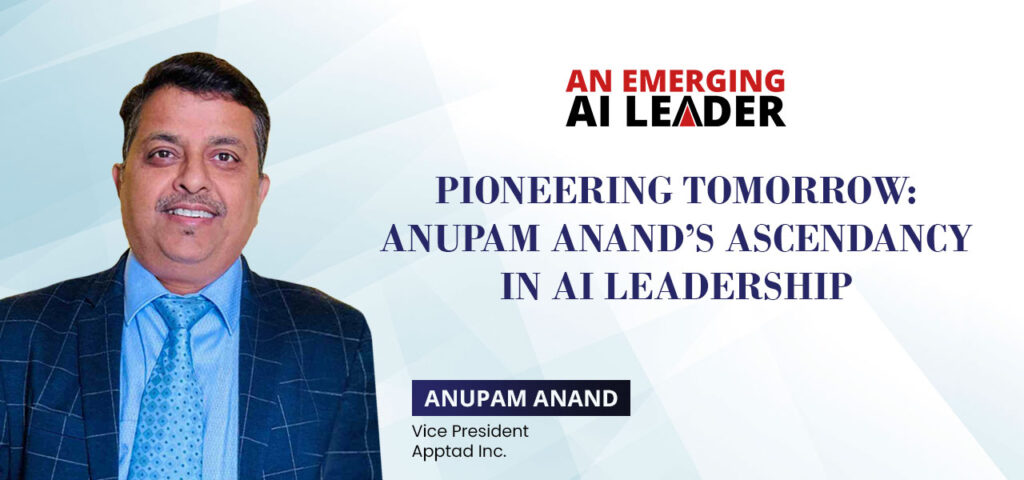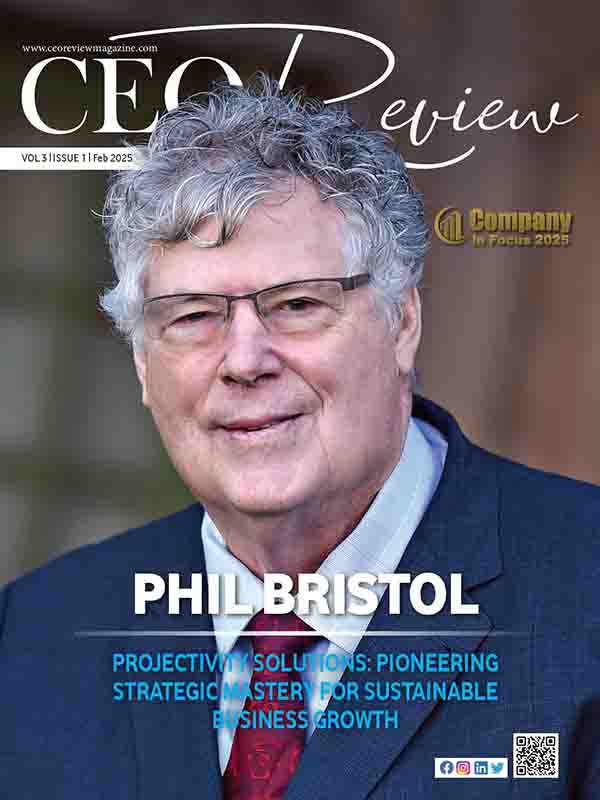Written By: Samridhi Jhingan
Leading with Insight: Anupam Anand’s Path to Value-Driven Smart-Tech Leadership

In today’s rapidly changing world of technology, Anupam Anand, Vice President at Apptad Inc., stands out as a leader who combines new ideas with strong values. A certified Digital Transformation Leader (IIM Lucknow), Anand is a professional with an experience of more than 20 years in leading machine learning initiatives. With his skills in language processing and advanced AI tools, Anupam Anand has brought major changes to the healthcare, finance, and logistics sectors in the country. His unwavering commitment to achieving technical success while upholding ethics and integrity has earned him several awards including the Innovation Marathon Award and two bronze medals for delivery of Enterprise Automation.
From Digital Transformation to Domain-Expert Smart-Tech Leadership
Anupam Anand began his journey as a professional with modernizing Fortune-500 companies. Initially, he was completely focused on enterprise digitization. However, with the coming in of Apptad in 2021, he started focusing on domain-specific smart systems. He prioritizes in-depth learning and NLP. He uses several creative methods to increase customer engagement, such as, using AI to create predictive models and recommendation engines. He promotes reinforcement learning and explainability along with GANs to improve learning. This also helps companies generate a larger business value.
What Sparked the Venture? Why does he find Innovation exciting?
Anand has always felt fascinated by Artificial Intelligence. AI has the potential to transform industries and improve people’s lifestyle by solving their day-to-day problems. Anand believes in the evolving nature of AI. He finds something new to discover and learn every time he interacts with AI. He focuses on frontier discoveries, such as the exploration of GenAI, research opportunities and new regulatory policies. He frequently attends conferences, academic lectures and other interactive sessions to polish his vision and skills.
Development of a Smart Resume System
Almost all companies go through the taxing process of resume screening every year. Apptad makes it easy by developing a smart and automatic resume screening process. In an attempt to transform talent acquisition, Anupam Anand and his team got together to create a dataset of candidate resumes, which they tied to specific job descriptions, while manually tagging important skills. Subsequently, they used NLP-LDA preprocessing tools to train classifiers to score resumes by fit. This AI system was created with an aim to simplify and speed up the recruitment process by reducing false positives and increasing precision
Critical Traits of a Visionary Tech Leader
Anupam Anand believes that a visionary tech leader should have a strategic outlook, fluency in using technology, adaptive communication, ethical grounding and passion for upskilling. A leader should be able to adapt complex systems into simpler models, making them easily adaptable and accessible to people. A leader is also responsible for motivating his/her team and enhancing their work performance.
Cultivating Creative Thinking in the Team
Anupam Anand uses several methodologies to promote innovation and creativity among his members. Firstly, he encourages his team members to experiment and explore their ideas. He also promotes partnerships among people from different disciplines, fostering healthy learning. He encourages his team to participate in conferences, seminars and other interactive and insightful activities to improve their knowledge and skills. He also rewards innovative and creative ideas of his team members publicly and also funds them for short-term trials. Engineers are also motivated to take up side projects. This open culture of active and consistent learning and regular feedback makes room for new, creative and innovative ideas.
Prioritizing Ethics
Anand considers ethics an important part of his company’s design. He works consistently to prevent unethical issues such as biases, privacy concerns, unclear decision making and misuse of technology. All of his AI systems are tested for transparency and fairness before they are launched. These initiatives reduce the risk of the company engaging in unethical practices.
Aligning Innovation with Business Goals
Anupam Anand ensures that his AI models align with the company’s aims and aspirations. He prioritizes the expectations of stakeholders according to which he sets objectives and KPIs to measure the credibility of his AI models. He encourages activities with a higher value and conducts cross-departmental collaborations to increase engagement of different stakeholders with the business idea. Regular feedback is taken from the stakeholders on the business model via frequent monitoring and reporting to ensure company satisfaction.
Introducing AI Tech into existing Business Systems
Anupam Anand believes in integration of AI into current business solutions. He focuses on carefully assessing the business model to identify its AI requirements, according to which his team shortlists certain AI technologies. The AI data is carefully prepared and integrated with the AI model, after which it is tested for efficiency. Once this is done, the AI solution is set for production and monitoring, while being subjected to feedback and changes from the organization.
Handling Conflict between different Teams
While describing a team conflict over the e‑commerce chatbot, Anand said he made customer satisfaction the top priority. He reduced disagreements between the customer care, IT and marketing teams by organizing conferences and interactive discussions to motivate them to share their needs and fears for the company’s clearer understanding. This practice revealed that all the teams shared some common goals such as reducing operational costs and enhancing customer experience. These goals were then worked upon in alignment with the company’s interests.
Role of AI in shaping the future of Industries
Anupam Anand believes in AI’s power and capacity to transform several industries such as healthcare, finance and transportation. By providing personalised treatment, high quality medical scans and predictive diagnosis of the patient’s condition, AI is reshaping the healthcare sector. Artificial Intelligence is also contributing to the transformation of the financial sector by managing risks, detecting frauds and improving customer satisfaction. Several AI traffic control models, self-driving cars and other managerial models are contributing to reshaping the transportation sector
Assessing the performance of AI models
Anand uses the right indicators such as accuracy, detection rates and recall for examining the performance of AI models. He then splits data into testing, training and final review sets to check how the AI model responds to new data. AI models are examined and improved frequently by Anand’s team to ensure its speedy and efficient performance.
Role of AI in expanding Human Intelligence
AI can benefit humans by increasing their decision making in a number of ways. It can quickly process huge amounts of data, helping humans make informed decisions. It also takes charge of the routine tasks of humans, helping them find more time to engage into creative tasks. AI also provides individual suggestions, predicts future trends and provides accurate updates to improve choice making. It can also detect biases, errors and unethical behaviour.
Building a Strong Professional Reputation
Recognized as a top AI voice on Linkedin, Anupam Anand advises professionals and visionary leaders to share useful insights, engage genuinely with people online and share their own personal experiences in order to build a brand based on trust and expertise.
Fast Arriving Future
Anand believes that the changes that were expected to be seen in the next 5-10 years would be seen in the upcoming 1-2 years. He thinks AI agents will be made for specific industries. He also expects the arrival of digital twins and specialized language models.However, he still pushes for an ethical system to drive the company forward in the right direction. He believes that industries which will be able to adapt with these changes quickly will lead the way, especially into sectors such as healthcare, finance and transportation.
Advice for Future Leaders
Anupam Anand strongly believes in learning, unlearning and reskilling to establish a big brand. He advises future leaders to develop strong technical skills, learn more about their sector, improve their communication and leadership skills, follow ethical practices and work hard to survive and make an impact in this evolving sector.
Also read: Varun Singh: Exemplifying Ethical Leadership in Global Investment Migration
Conclusion
This is a great example of how passion for your work can make a real difference in people’s lives. It’s inspiring to learn from his knowledge, experiences, and forward‑looking ideas about AI. These insights motivate both leaders in various organizations and young professionals starting their journey in this field.
In today’s fast‑changing world of artificial intelligence, it’s important to guide its growth with smarter, more efficient, and ethical decisions. This interview has been truly insightful—thank you, Anupam Anand and CEO Review Magazine, for sharing this conversation. May your work in AI continue to inspire and empower us all.







